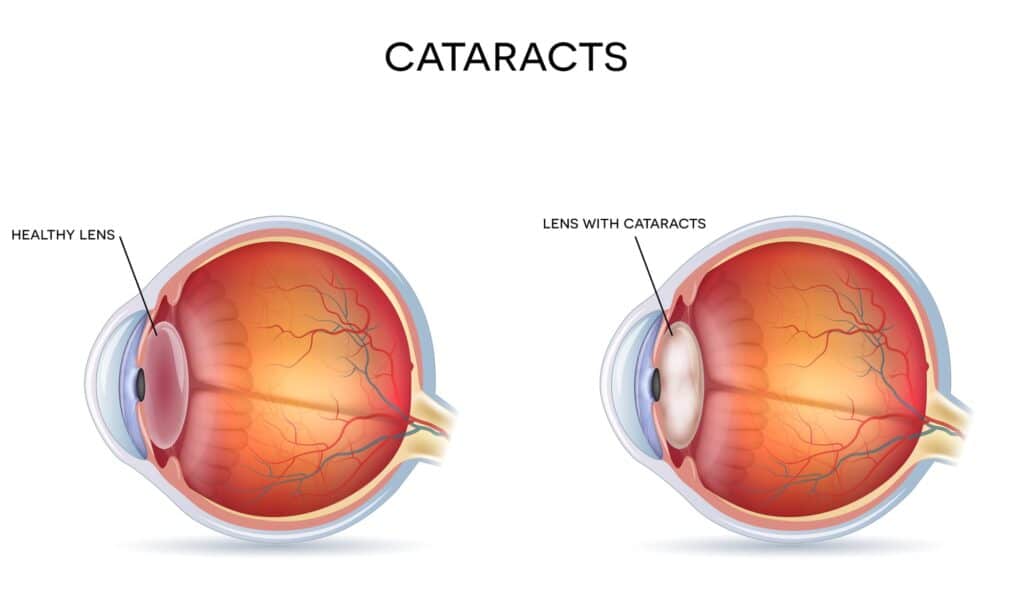Cataracts are, without a doubt, one of the leading causes of blindness globally. While most people experience cataracts at some point in life, the majority know less about what they are. Cataracts are often associated with a cloudy or white pupil, which might be visible to the naked eye or not. Affected persons may also report difficult night visions, abnormal color perception, and blurry vision.
Interestingly, it can affect anyone at any age. If you start experiencing visual problems, consulting an ophthalmologist is important for an accurate diagnosis and treatment.
What is a Cataract?
A cataract involves thickening and clouding of the eye lens. For healthy eyes, light passes through the lens, just like in camera lenses. However, this becomes impossible for those with cataracts, as the thickening prevents light from passing through the eye properly to project a clear perceived image on the retina. Clouded vision caused by cataracts makes it challenging for the affected persons to read, drive at night, and become sensitive to bright light. Cataracts develop slowly and might not affect eyesight initially. However, they progress and interfere with vision over time.
Types of Cataracts
While cataracts manifest with almost the same symptoms, they are of various types. Among them include:
- Nuclear sclerotic cataracts – nuclear cataracts affect lens’s center and may cause nearsightedness initially or a temporary improvement in reading visual acuity. However, as it progresses, the lens becomes densely yellowish, which clouds your vision and blocks lights.
- Cortical cataracts – they affect your edges lens. They start as white cloudiness or streaks appearing at the outer edge of the eye lens. The streaks then extend to the center, interfering with light passing through the center.
- Posterior subcapsular cataracts – subcapsular cataracts affect the back of the eye lens. They often start small, with an opaque area forming at the lens’s back, just the light path. Posterior subcapsular cataracts affect the reading vision and are responsible for reduced vision when exposed to bright light. It also causes halos or flares at night.
- Congenital cataracts – as the name suggests, these are cataracts that some people are born with. They can be genetic or occur due to intrauterine infections and trauma. They can also be due to galactosemia, myotonic dystrophy, rubella, and neurofibromatosis. They significantly affect vision but often resolve once the causative factors are removed.
Symptoms of Cataracts That Occur Before Becoming Visible
Despite cataracts being a common eye condition, most people don’t know their manifestation. Some signs and symptoms of cataracts include;
- Sensitivity to light – light sensitivity is among the common symptoms of cataracts. Affected persons experience pain glaring to bright lights, especially those with posterior subcapsular cataracts. This is because this type blocks the path of light and interfere with reading vision.
- Dull colors – cataracts cloud the eyes, thus interferes with the normal color perception.
- Double trouble – diffraction from the affected eye lens caused by clouding may make you perceive two or more images of the same object. Besides cataracts, other causes of diplopia include multiple sclerosis, stroke, stroke, brain tumor, and corneal swelling.
- Difficulty seeing or driving at night – patients with cataracts can report worsening of night vision. This is because cataracts dim and darken vision. Such early changes might not be noticed during the day at the early stages but become apparent at night.
- Blurred vision – this is among the first symptom of cataracts. Patients report that their eyes do not focus well, and vision appears cloudy.
- Halos – as mentioned, clouding leads to abnormal diffraction of light as it enters the eye. This leads to the formation of halos, especially around light sources. Patients can report rings around light sources, which vary in color.
Visit Us for Cataract Detection and Care
Cataracts definitely lead to significant alterations in vision. However, note that cataracts don’t appear only in old adults but can also occur in young people. Genetic conditions, medications, and injuries can cause cataracts. If you have some of the symptoms mentioned above, book an appointment with our ophthalmologist. They can examine the symptoms to determine if cataracts are the cause of your eye problems.

